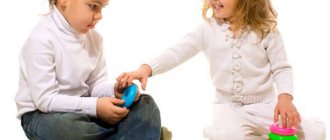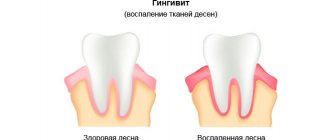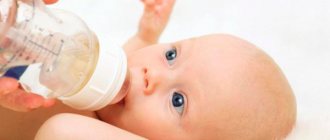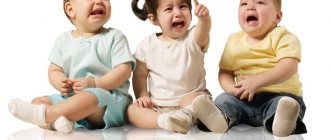At what age should a child be taught to dress and undress independently?
From the age of 1.5-2 years, children begin to actively show curiosity. They want to learn more and more information, help their mother with housework, and, of course, dress up and dress up. Do not protect your baby from this knowledge; this is the most appropriate age to start learning to dress independently .
Svetlana Andreevna, 27 years old, mother of 2 children “After bathing, let the baby put on her underwear on her own. When getting ready for a walk or a visit, let him try to put his feet into tights and put on socks. Try not to help him with this unnecessarily. Let him dress crookedly, askew, on the wrong side, but he will try to dress himself.
The same goes for undressing. Tell your child to take off, for example, tights or socks. Also, before swimming, ask to undress yourself.”
If the baby does it poorly or doesn’t succeed at all, then help him before he starts crying.
Negative memories of not being able to do something will have a detrimental effect on further learning.
Olga Sergeevna, 34 years old, mother of three children “Naturally, do not force a child at this age to dress or undress himself if he categorically does not want to. Put everything into a game form. For example, say: “Let’s play, who will take off the sock faster - you or me?” The children try very hard to win the competition, even at such a young age.”
Looking for motivation for a child
Developing independence is always a task of finding suitable motivation for the child. It is difficult to find a universal recommendation here. Look for what will motivate your child, look for the right words, observe what situations push him to activity. And evaluate motivation not from the position of “why does the mother need this,” but from the position of “why does the child need this.”
For example, my eldest son Arseny did not want to clean his shoes. Because “that will do.” The mother needed polished shoes, not the child. I polished my right shoe to a shine. In contrast, the left one began to lose greatly, and it became clear that “this won’t do.” As a result, Arseny already cleaned his left shoe himself - the motivation for this appeared.
And the youngest, Sasha, didn’t have to be motivated - he wanted to clean his shoes himself. He was three years old when he begged me for a personal shoe-cleaning sponge, jealously made sure no one took it, and wiped his shoes with it every evening.
It was important not to miss this moment of personal interest. Once upon a time, at the same age, Arseny wanted to clean his shoes himself, but I didn’t allow him, because “dirt, germs, he’ll get dirty, he’ll get sick.” (Alas, I was not always a “lazy mother.”) If you don’t give the opportunity to try and learn when there is interest in it, it is not at all a fact that when the child “grows up”, he will retain this interest.
Why is it necessary to teach a child to dress and undress by the age of three?
By the age of three, a child must be taught to dress and undress! After all, it is at this age that he will go to kindergarten. Perhaps for some it’s earlier or later, but all the same, at three years old the baby should be able to put on and take off pajamas, swimming trunks, a T-shirt, tights, skirts or pants, felt boots or boots (sandals), a hat and a jacket (without even buttoning them up) .
Anastasia Dmitrievna, 31 years old, mother of twins “There are many kids in kindergarten, but only one teacher. He will not always be able to approach each child in time to help change clothes for bedtime, and even more so when getting ready for a walk.
Of course, if a child is not very good at getting dressed on his own, warn the teacher about this, he will pay attention to his composure and help if he fails to get dressed.”
Also, in a group, children will learn to dress faster, because childhood is constant competition and gaining authority.
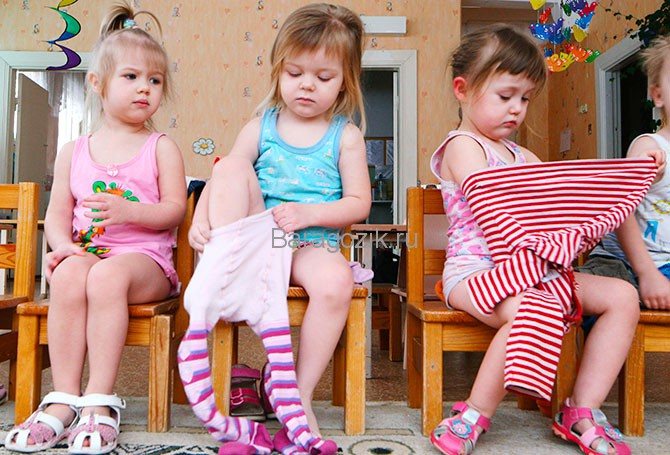
If you are not going to take your baby to preschool, then you should also take care of teaching him how to change clothes independently. By the age of three, a child should be able to do this. Success in further education, the development of fine motor skills of the fingers, and his academic performance depend on how quickly a child learns to dress and undress. Each learning must take place at its own time.
How to teach dressing
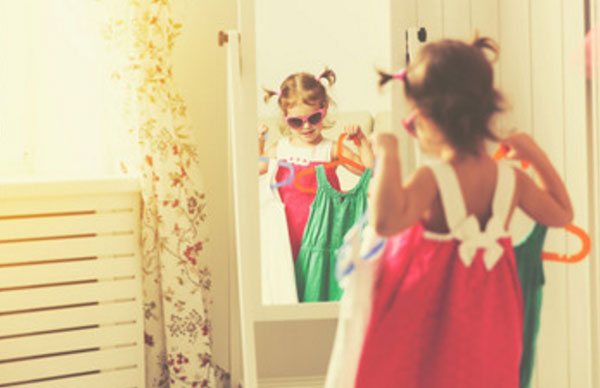
It is important that the child knows how to wear a minimum of clothes when he grows up and ends up in kindergarten, because he will not be the only toddler there. Try to teach your baby to be independent from early childhood.
In order to teach your baby the process of proper dressing, you need to use the following algorithms.
Teaching a child to dress and undress independently: where to start?
Of course, every business needs its own beginning. The same goes for teaching your baby how to dress himself.
Anna Evgenievna, 37 years old, mother of many children “If the baby does not show the initiative to start changing clothes on his own, then dolls, soft hares and other toy animals will help you. Sew or buy several of the most common clothes for these toys: a dress, trousers, a shirt, a T-shirt and socks. Play with your baby, show him how to dress and what to wear where.
When things get moving, when getting ready for a walk, ask him to take a toy with him, explaining your desire by saying that the toy is bored and also wants to go for a walk. Ask your baby to dress this toy on his own, because you don’t have time - you dress him and yourself, and even a doll can’t go outside without clothes.”
Aliya, 29 years old, mother of two children “Pay the baby’s attention to how the buttons are fastened, how to put on the toy correctly and in what order.
After a few days, you will notice that the child has begun to show interest in dressing himself, because it’s so great to help his mother and be independent.”
For every success in dressing the same toy, do not forget to praise the baby, ask him to put the socks on himself just as well, because you will not succeed as well as he can.
Also, when dressing your baby, take your time, do everything slowly so that he can follow your actions and remember them.
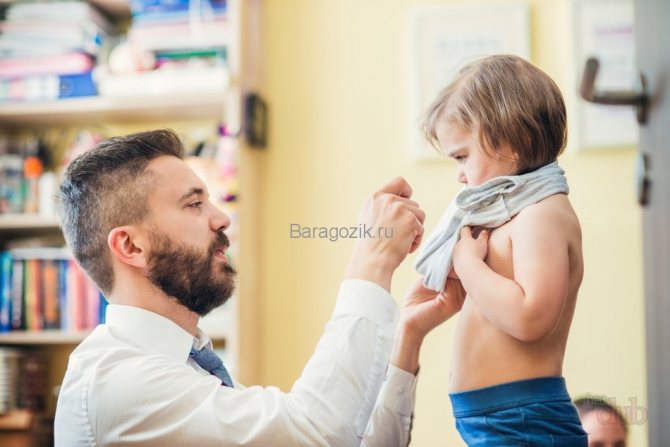
Explain to your child why a T-shirt is worn under a T-shirt, and not vice versa. Also tell him why he should fasten buttons and zippers, and why he should tie his shoelaces.
Elena Vladimirovna, 41 years old, kindergarten teacher, mother of three children “Develop your baby’s fine motor skills with various buttons, balls, and cord labyrinths. There are a wide variety of such toys sold in stores. In addition to motor skills, they also develop logical thinking.”
Conversations with parents about children’s clothing in the group and on the street
Conversations with parents about children’s clothing in the group and on the street, and their labeling
Conversations about clothes. How to dress a child correctly
Dressing your child correctly means protecting him to a large extent from colds, giving him the opportunity to move freely and feel comfortable.
Clothing helps maintain a constant human body temperature and protects him from adverse environmental influences. In cold weather, rational clothing protects against excessive heat loss; in hot weather, it does not interfere with good heat transfer.
The clothing itself does not heat, but between it and the body, as well as in the pores of the fabric, there is air, which is a poor conductor of heat. The greater or lesser heat-retaining properties of clothing depend on its cut, the number of layers and the quality of the fabric from which it is made. The fabric retains heat better the more air it contains. Soft, loose fabrics have a high heat-protective ability: wool, corduroy, knitwear, fleece, padding polyester. The advantage of all these fabrics is that they all have good breathability, ensuring a change in the air between clothing and heat. These fabrics are used to make clothes intended for the cold season.
For summer clothes, smooth cotton fabrics are used. The valuable qualities of these fabrics are their breathability and hygroscopicity - the ability to absorb moisture well and quickly and gradually evaporate moisture. Linen, while absorbing moisture well, evaporates it faster than other fabrics. Clothing made from linen is especially good in hot weather, as it helps cool the body.
Children's underwear - a layer of clothing that fits directly to the body - should be made from natural materials. Cotton underwear does not irritate the skin, easily absorbs sweat, and does not interfere with normal air exchange with the environment.
Materials made from synthetic fibers do not absorb and evaporate moisture well and have low air permeability compared to natural fabrics. Therefore, they are not used for children's underwear and summer clothes. The good water-repellent and windproof properties of synthetic fabrics allow them to be used for making outerwear for cold, wet and windy weather. On warm, dry days, you should not wear such clothes, since they, not having sufficient hygroscopicity and breathability, delay the evaporation of moisture and contribute to overheating of the body.
Clothing must be appropriate for the child's age, gender, height and body proportions. It should not restrict movement, interfere with free breathing, blood circulation, digestion, irritate or injure the skin. Tight belts and high, tight collars are unacceptable. You must carefully ensure that the elastic band of the panties or the belt of the baby’s other clothing is loose enough and is located exactly at the waist, that is, between the upper part of the hips and the lower part of the ribs. An elastic band or belt that is too tight and high will compress the child’s chest and restrict his breathing.
Walking clothes
It is equally harmful for children to be overheated or overcooled. The number of layers of clothing depends on the air temperature. Additionally, wind speed must be taken into account. It has been noticed that at the same negative air temperature, a person freezes the more, the higher the wind speed. This property of the wind was studied by the American geographer and Antarctic researcher Paul Siple and, based on the data obtained, developed the so-called wind cold index. For example, the effect of a temperature of -5°C with a wind of 10 m/s corresponds to the effect on the body of twenty-three degrees below zero.
The individual characteristics of the child are of great importance. A sedentary, constantly chilly child should be dressed warmer than an active one. Babies who are overly bundled up can be found much more often than those who are not dressed warmly enough.
Many mothers, when going for a walk, try to dress their child warmer than they dress themselves. But if this is a walk during which the child is constantly moving and the mother is watching him, then this is wrong. A sweaty child is much more likely to get sick than a child dressed for the weather. In addition, sweat can cause irritation and rashes in the child.
Children should be dressed no warmer than adults, and perhaps even lighter. (We are not talking about children “walking” in strollers; they need additional protection.) At home, a baby who is dressed too warmly gets tired faster.
When dressing your child, remember that children freeze less than adults and move more.
Clothes for different seasons
In hot weather, it is necessary to wear clothes made of cotton fabric, which provides rapid heat transfer and protects against overheating. In summer, in warm sunny weather, children can wear light, single-layer sleeveless suits or sundresses; they should wear a light-colored fabric panama hat or a hat with a visor to protect them from the sun.
In spring and autumn in rainy weather, outerwear should be made of waterproof material with a lining that has good heat-protective properties. Jackets or overalls with padding polyester lining are very comfortable: they are light, quite warm and, importantly, easy to wash and dry quickly. The number of layers of clothing between the underwear and the jacket depends on the air temperature. If it’s cold outside, instead of one thick warm thing, it’s better to wear two lighter, less warm ones. An air layer is created between layers of clothing, which helps retain heat. Thinner things do not restrict movement and weigh less, which is very important for a child.
Winter outerwear protects children from cold, wind and moisture, and therefore must consist of at least two layers: a lower layer that is heat-protective and an upper layer that is windproof and prevents outside air from penetrating under the clothes. The design of winter clothing should ensure greater tightness, preventing the entry of cold air through fasteners, collars, and sleeves.
The cut of clothing is of great importance in preventing hypothermia. A set of a jacket and overalls (insulated trousers with a chest and back with straps) is the most comfortable. When the child moves actively (bending over, raising his arms up), the jackets rise, exposing the lower back, and the back of the overalls covers it. One-piece overalls are not suitable for walking preschool children: they hinder movement, are inconvenient to put on and are more difficult to clean and dry after a walk.
Between underwear and outerwear (depending on the weather) there can be a shirt and a sweater or just a shirt, tights and leggings or just tights.
In cool weather, as well as in winter in the absence of severe frosts, children are recommended to wear knitted hats that cover their forehead and ears well. In severe frosts, to ensure a tight fit under a warm hat, you should wear a thin knitted cap with ears, which is tied under the chin. A jacket hood worn over a hat provides good protection from the wind.
In conditions of frequently changing weather, there can be no universal winter or autumn clothing. The child’s clothes need to be selected daily, depending on the air temperature, humidity and wind strength.
And remember: a worn item is colder than a new one. Keep this in mind if your younger child wears the jacket after your older one.
A child wears street clothes not only when going for a walk, but also on public transport and in stores. In these cases, you need to be able to remove some of the clothing so that the child does not sweat.
In any case, clothes should be clean, beautiful, bright and cause joy and good mood in the child.
Clothes for kindergarten
When getting your child ready for kindergarten, think about whether it will be convenient for him to dress himself, and whether it will be convenient for teachers who gather a whole group of children for a walk. Zippers and Velcro are preferable to buttons, a knitted shirtfront is more comfortable and reliable than a scarf, mittens sewn to an elastic band will not get lost, and a helmet cap will tightly cover your ears.
To avoid overheating while getting ready for a walk, children in kindergarten are taught to dress sequentially: first, “bottoms” - tights, trousers, socks, boots; then the “top” - a sweater, a hat and - last but not least - a scarf and jacket.
Clothes for staying in a group should be as comfortable as possible and not restrict the child’s movement. Soft jersey pants are more comfortable than stiff jeans or denim overalls. A T-shirt or jersey jumper is preferable to a shirt. Elastic suspenders are dangerous - when moving, metal or plastic fasteners can come unfastened and injure the child's head. In addition, suspenders, straps, and overalls make it difficult for a child to change clothes and create inconvenience when visiting the toilet.
If your child is prone to sweating, when preparing him for kindergarten, you need to take a spare T-shirt with you so that the teachers can change him.
The child’s clothes (for walking and for being in a group) should have a pocket for a clean handkerchief.
Clothes care
When soiled, the weight of clothing increases (in 10 days of wear by 10-11%), its thermal and hygroscopic properties decrease, and the number of microbes in it increases. Therefore, contaminated clothing must be cleaned and washed promptly and thoroughly.
Clothing should be changed whenever soiled. It is recommended to change underwear, socks, and tights daily.
For washing cotton laundry, machine washing is the most practical option. When washing by hand, you must rinse the laundry very thoroughly. When washing woolen items, certain requirements must be observed to prevent the items from matting or shrinking: wash the items in warm water, squeezing them lightly, do not twist or rub them, rinse 3 times in water at the same temperature as when washing, wring out in a towel , dry flat.
The pajamas a child wears to sleep in kindergarten need to be washed every week, just like the sports uniform the child wears to physical education classes.
To wash children's clothes, you should use special powders or baby soap intended for this purpose.
"Correct" shoes
As soon as the child begins to stand on his feet and try to walk, he needs to put on shoes. According to experts, up to 60% of flat feet and other disorders of the formation of the arch of the feet are associated with improperly selected shoes. Therefore, it is important for parents to know what to look for when choosing children's shoes.
You should buy shoes from well-known companies that have quality certificates. Shoes from unknown manufacturers pose a great risk to a child's health.
The upper of the shoe should be made of materials that allow air to pass through - leather, suede, textiles. If possible, try to avoid synthetic materials. Before purchasing, check the inside surface of the shoes: there should be no rough seams or unevenness.
Pay special attention to the presence of an instep support - one of the main elements of “correct” shoes, which is a dense elevation on the inside of the insole. The instep support supports the arches of the feet and helps distribute the load evenly when walking. In corrective orthopedic shoes, the instep support can be rigid and very high. But such shoes should be chosen only on the recommendation of a doctor.
The sole of the shoe should be dense, not flexible, but pliable for shock absorption when walking. With a completely flat sole, it is more difficult to maintain balance when walking. For normal posture and proper arch formation, you need a small heel. On the first shoes, the recommended heel height is 5-7 mm, by two years - 1-1.5 cm. The heel should be high, dense and continuous, without seams or folds. Choose shoes with a wide round toe so your toes can move freely.
Tight shoes can lead to changes in the shape of the foot, promote ingrown nails, and the formation of calluses. By squeezing blood vessels and impairing blood circulation, tight shoes help cool your feet in the cold season. Shoes that are too loose are also undesirable, as they impede movement and cause abrasions on the feet; wearing shoes that are designed to grow, a child falls more often, and his posture is disturbed. Shoes must fit correctly - the inner length of the shoe should be 1 cm greater than the length of the standing child's foot. The foot and toes should not be squeezed.
To avoid making mistakes when purchasing, place your child on a piece of cardboard at home and trace his feet with a pencil. Cut it out, compare the two prints (one may be larger), and take the larger print with you to the store. Put your fingerprint on the models you like - this way you will determine the ones that are suitable. When trying on, place your finger between the heel and heel. If the toe doesn't fit, the shoe is too small. If it fits freely, it's too big. Try on winter shoes with a wool sock.
The baby's feet are growing quickly, his first shoes will quickly become too small for him. You should check frequently to see if he feels comfortable, and when you are sure that your baby's big toe touches the toe of the shoe (with the child standing), you need to buy him a new pair of shoes.
There are indoor, outdoor and sports shoes. Shoes for kindergarten are an option for home shoes. Children should not wear flip-flops of any kind or soft, loose cloth slippers. House slippers should resemble shoes - tight-fitting, open, with good ventilation.
It is not recommended for a child to walk barefoot at home. Walking barefoot on flat, hard floors can delay the development of arches and contribute to increased flat feet. In the summer, when it is warm enough and there is no danger of injuring or splintering their feet, it is necessary and beneficial for children to walk barefoot on the ground, grass, wet sand, and pebbles.
Street shoes are more closed than indoor shoes. In the warm season, textile shoes are comfortable - lightweight, breathable and hygroscopic. If you buy sandals, the child's foot should be tightly secured with straps. To prevent injuries, it is better to choose a closed toe on street shoes. Rubber boots with insoles or covers made of fabric that absorb moisture well are worn in relatively warm weather while walking on wet ground and grass. Do not wear rubber boots to your child (at least until 3-4 years of age) too often or for a long time - the feet in them become very sweaty. At low air temperatures, it is better for children to wear leather boots.
In winter, when walking, you should wear insulated leather boots, and in very cold weather, felt boots with galoshes. Upon returning from walks, shoes must be cleared of snow and dried. Make sure that winter shoes are not too small for your child. Boots or boots that are a little large can be worn with two pairs of socks.
Sports shoes should support the foot during active movements. To prevent injury, a non-smooth, shock-absorbing sole and tight fit are important. Velcro or laces allow you to achieve a perfect fit for your legs, taking into account their anatomical features. Children wear Czech shoes only for music classes; they are not suitable for physical education classes. The thin leather sole slips and does not absorb shock; the shoes also do not provide fixation and support for the foot.
Orthopedists do not recommend wearing someone else's used shoes. Worn-out shoes will not tightly fix the foot in the correct position, and if the previous owner had a foot deformity, then the defects that arise during wear will have an adverse effect. Only rubber boots or practically never worn shoes can be passed on by inheritance.
It is equally important to choose the right socks. They must be the right size - small ones compress the legs, and large ones gather in folds and contribute to the formation of abrasions. Socks with a heel are much more comfortable than socks without one. Quality socks have thicker material on the heels and toes than elsewhere, making them more durable.
Socks made from natural fibers (cotton and wool) absorb moisture better and allow your feet to “breathe.”
Choosing the right clothes for your baby
How well clothes are chosen for a child will determine his success in learning to dress and undress independently, and his desire to continue learning.
We have compiled the most common advice from experienced mothers on what you should pay attention to when choosing clothes for your child:
- Do not buy clothes with small buttons for a 2-3 year old child . The fine motor skills of the child’s fingers are still poorly developed, so it will be difficult for him to cope with small details on clothes.
Solution: if you still couldn’t resist and bought something you liked with small buttons, then replace them with larger ones or simple rivets.
- Buy clothes with your child, be guided by his choice . It is simply impossible to force a child to wear things that he does not like. He will run away, scream, but will not put it on, especially on his own. If you didn’t like what your baby chose, then remember: it’s not you who should wear the clothes, but him. It’s easier to buy something that your child likes than to force him to wear something he doesn’t like.
Solution: if there are things in your baby’s wardrobe that he doesn’t like and doesn’t want to wear, then don’t force him. It’s just that if you catch him and force him to wear such a thing, then next time he may simply refuse to dress on principle.
- Choose only comfortable clothes made of quality material . If the child feels uncomfortable in clothes, he feels hot or cold in them, then you will again be faced with a complete refusal to dress. And you can’t even count on putting on such a thing yourself: children are distinguished by their spontaneity - “it’s uncomfortable, I won’t wear it.” It is women who can run around in uncomfortable stilettos all day and put them back on the next, but children do not tolerate the inconvenience.
Solution: simply remove inconvenient, narrow and low-quality items. It is advisable to completely hide them or give them away so that the baby does not see them. Things that cause discomfort can trigger a bad mood.
- Buy T-shirts, sweaters and pajamas with a wide neck so that the baby can freely stick his head in there . This mother can simply make an effort to squeeze the baby into the jacket. The child himself, after the first unsuccessful attempt to stick his head through the collar, will abandon this idea.
Solution: if you bought a jacket without a baby, and while trying it on at home, you noticed that the collar is tight, you can embroider it yourself, or make an incision on the collar, trim it and sew on a beautiful button. The baby will be able to put on the sweater on his own, and the button will be fastened by you or by the teacher in the kindergarten.
- Buy shoes with Velcro, not laces . A child aged 2-3 years will not be able to tie his own shoelaces. Solution: there are shoe models that have lacing and a lock (or Velcro).
How to behave
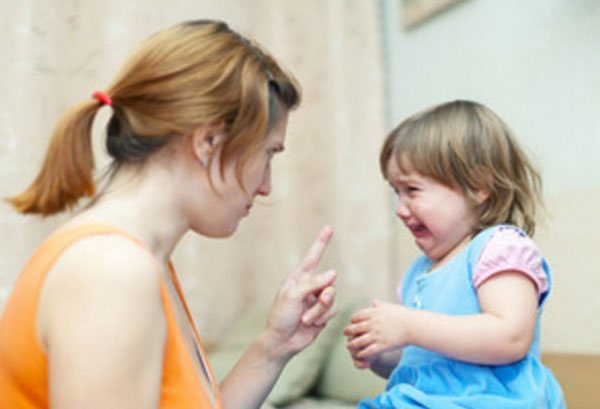
Remember to remain completely calm
- Keep calm. Accept that the process of getting dressed and undressed is normal. Over time, the little one will get used to it. Sooner or later the skills will be consolidated. Therefore, you should not threaten your child, give him ultimatums, or blackmail him. With this behavior the results will be zero. It is better if your actions are gradual.
- Think about how collections will take place in advance. Prepare things by determining the order of what to wear first and what to wear last.
- You need to act carefully, excluding sudden movements. You must be careful and attentive. It is important not to hurt the child during the dressing process.
- Before dressing your little one, make sure that the size of the clothing is appropriate, that there are no convex seams, and that the inside is not scratchy. Make sure your child is feeling well and has no skin rashes. If “defects” in clothing are found, change things; if there are health problems, consult a doctor.
- Share the labor. Let the baby put on some things, and let the mother help with some things. At the same time, you can tell the little one that “he is his mother’s assistant.”
- You can resort to playing. For example, a baby's hand entering a sleeve is a train entering a tunnel. And when putting on a sweater, at a time when the child’s head has not yet come out through the collar, it’s a “game of hide and seek.” In addition, offer your child to dress dolls or soft toys.
- It is unacceptable to compare your little one with others, saying it out loud. Such behavior will not only upset the baby, but also reduce his self-esteem.
How to teach your baby to dress correctly: what should you pay attention to?
| Tights and socks | This is the first thing a child needs to learn how to dress on his own . Children repeat everything after adults. Explain to your baby where the “back and front” of the tights are (by stripes: one for the front, two for the back). Show where the heel and toe of the socks are. Show yourself how to wear these things correctly, and let your child repeat everything after you. |
| Sweatshirts, T-shirts and tank tops | Explain to your child that it is easier to put these things on starting from the head, and then stick the arms through . Buy these items with colorful appliqués on the front and front to prevent your little one from confusing the sides and back with the front. Every time you start getting dressed, tell him that this is the front, because there is a pattern there. |
| Shoes: laces and buckles | The baby already knows why laces and fasteners are needed, all that remains is to teach him how to use them correctly. We have already said that it is better not to purchase shoes with laces yet. Teach your child to tie knots on strings, and buy such shoes only by the age of four. The same applies to fasteners. Buy sandals with such a lock, but wear them only for walks when you can help your baby yourself. For kindergarten, buy shoes with Velcro and zippers; it will not be difficult for your child to deal with such locks. Left or right shoe? This is also very easy to explain by the same fasteners or locks; they are always on the outside of the leg. |
| Hats and ties on hats | In order for the child to easily remember where the front and where the back of the hat is, buy them also with a pattern on the front, showing that there is a seam at the back. It is better to teach your child to put on a hat in front of a mirror, so that he can see for himself how he is doing and what needs to be corrected. Avoid ties at this age; there are many hats with Velcro and drawstrings. |
| Lightning | Nowadays, almost all jackets are made with zippers, so you have to teach your child how to use them by the age of three. Learn to fasten zippers on unworn items . Place the jacket on the bed and work with your baby to fasten and unfasten the zipper. When he does a good job, continue training on yourself (let him button the jacket on you), and then try to button it for himself. |
| Buttons and buttons | When teaching your child to fasten buttons, explain to him that each button needs to go into its own “hole,” and the same with buttons . Show how ugly and uncomfortable it will be if you fasten them incorrectly. Choose clothes with large snaps and buttons. |
Teaching a child to dress independently
Age: 2 years - 5 years Topic: Education, Care and hygiene The ability to dress independently is a significant achievement in the life of every child.
It becomes especially important if the child has to go to kindergarten, where he needs to change clothes several times every day. How can parents teach their child to pull on tights and deal with unruly sweaters? If your child is not very good at buttoning outerwear and sweatshirts, discard numerous buttons and buckles until better times. Start with something simple: explain to your baby again that the label is always sewn on the back, and this is the first thing you need to pay attention to when changing clothes. Next, show that the top of the head should be inserted into the collar, not the face. Lay the sweater or jacket on the floor and, sitting with your back to it, demonstrate how the ends of the sleeves are held and the arms are threaded through them, and then how the jacket is draped over the shoulders. When the child learns and brings these simple rules to automaticity, you can begin fastening zippers, buttons and buttons. It is better to practice these actions on large soft toys and dolls. Take out baby clothes and invite your baby to practice putting them on on toys.
Tights and socks
Children spend most of their time putting on tights and tight leggings.
To make the task easier, pre-stretch freshly washed tights with your hands. But most importantly, teach your child not to immediately stick his leg into them, but to assemble the tights with an accordion. Patiently help your child with pulling, but ask him to make the accordion himself and stick his toes into the sock. Over time, complicate the process by offering to find the heel and pull the tights to the middle of the calf, and then to the knees. Of course, all this does not happen in one day or even in a week. In the same way, a child is taught to put on socks. By the way, you can buy them a size larger to make it more comfortable for your baby to train. However, in this case, the socks should have a thick elastic band and a clearly marked heel.
Of course, trousers are much more difficult to put on than skirts. The main problem is that small children do not know how to balance on one leg, so they need to get dressed while sitting on a bench or low chair. Impatient kids try to fit both legs into their pant legs at once. Parents should explain that it is important to do everything one by one and slowly. Show that one foot should land on the floor before the other leg can be inserted into the pant leg. It is best to start training with shorts - this way the baby will not get tangled in long pants. And only then practice the skill of pulling trousers along the length of your leg.
Until about 4-5 years of age, it is advisable to buy trousers and skirts with an elastic waistband for your child, since it is difficult for small fingers to cope with a large, tight button on jeans.
Shoes
To quickly put on shoes, the child needs to understand that the toes must reach the toe of the shoe.
Show how to properly “hide” your toes inside the shoe and push the foot all the way through. Also show how to hold the back wall of shoes or boots with two fingers when you need to take off your shoes and pull your foot out. Do not confuse the ability to put on shoes and tie shoelaces. Most children begin to successfully manage shoelaces closer to the first grade. In the meantime, Velcro shoes are considered the ideal option.
Mostly, children take a long time to learn how to dress simply because parents do not set aside separate time for training, but give instructions hastily before leaving the house. Of course, in order not to be late, the adults themselves volunteer to button the baby’s jacket and tie the scarf. As a result, the child does not practice skills and sees no reason to dress independently. There is no need to rush to help if a child makes a mistake while trying to put something on himself. The baby must understand for himself what he is doing wrong. Help only when he asks you to. If a child dresses himself, this is worthy of great praise. And it doesn’t matter that the T-shirt is sloppily tucked into trousers or a skirt. Parents' critical comments on this matter will only discourage the child from trying further. Also, do not yell at your child when he makes the same mistake over and over again, because this only means that he needs to explain something again and in a more accessible form.
Address your question to your pediatrician
schoolofcare.ru
What to do if a child refuses to learn to dress and undress?
If your baby doesn’t want to change into any clothes on his own, then try to bribe him with a new toy or extra sweets. Usually children agree to this agreement.
Evgeniya Savelyevna, 31 years old, mother of two children “You can start teaching him in a playful way. Say that tights and pants are magical tunnels, and the baby’s legs are trains. Use your imagination, say that this is not just a jacket and trousers, but a superhero costume that will only work if the child puts it on himself.”
Tatyana, 35 years old, mother of four children “Arrange a competition: who can complete the collection the fastest: adults or children. You yourself should take part to make it more interesting and fun.”
Do not scold your child under any circumstances if he refuses to dress himself, this will completely discourage his desire to learn.
